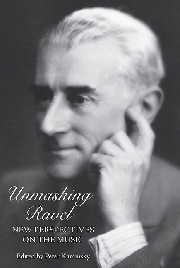Book contents
- Frontmatter
- Dedication
- Contents
- Acknowledgments
- Introduction
- Part One Orientations and Influences
- 1 Ravel's Poetics: Literary Currents, Classical Takes
- 2 Re-presenting Ravel: Artificiality and the Aesthetic of Imposture
- 3 Adorno's Ravel
- Part Two Analytical Case Studies
- Part Three Interdisciplinary Perspectives
- List of Contributors
- Index
1 - Ravel's Poetics: Literary Currents, Classical Takes
from Part One - Orientations and Influences
Published online by Cambridge University Press: 05 September 2013
- Frontmatter
- Dedication
- Contents
- Acknowledgments
- Introduction
- Part One Orientations and Influences
- 1 Ravel's Poetics: Literary Currents, Classical Takes
- 2 Re-presenting Ravel: Artificiality and the Aesthetic of Imposture
- 3 Adorno's Ravel
- Part Two Analytical Case Studies
- Part Three Interdisciplinary Perspectives
- List of Contributors
- Index
Summary
In a panegyric published in La Revue Musicale (1921) that set the tone for much subsequent Ravel criticism, Alexis Roland-Manuel stated that if “the composer of the Poèmes de Mallarmé were ever asked to describe his poetics he would simply refer his interlocutor to Edgar Allan Poe's essay “The Philosophy of Composition.” There, famously, the American poet explained how “The Raven”—and by extension, all of his poetry—was conceived not in a state of “fine frenzy” but rather as an assembly of “wheels and pinions” and “with the precision and rigid consequence of a mathematical problem.” During the creative process, considerations of duration, tone, design, and phonetics preceded the invention of the poem's subject matter and matrix of metaphors. Four years later, Roland-Manuel reaffirmed Ravel's connection to the American writer in another Revue Musicale essay, this time by citing Charles Baudelaire's preamble to his translation of Poe's essay, including the memorable assertion that “accidents and the irrational were [Poe's] two great enemies.”
One of Roland-Manuel's objectives was to champion Poe in order to distinguish Ravel's art from that of his contemporaries. For example, long-standing aesthetic enmity against Vincent d'Indy emerges in his claim that Ravel's works do not adhere to the “religion of the lied à cinq compartiments or the cult of sonata form” (the choice of the word “religion” is a barb in this formulation). Ravel's use of older forms, says Roland-Manuel, is inspired and free-spirited, not pedantic and wedded to preconceptions of Truth.
- Type
- Chapter
- Information
- Unmasking RavelNew Perspectives on the Music, pp. 9 - 40Publisher: Boydell & BrewerPrint publication year: 2011



